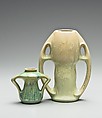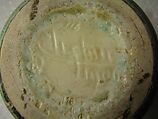Vase
Manufacturer Clifton Art Pottery American
The Clifton Art Pottery was founded in 1906 by William A. Long, a peripatetic ceramist from Ohio. He had worked in imitation of Rookwood Pottery’s Standard ware at the Lonhuda Pottery in Steubenville, Ohio, and then moved to Denver where he founded the short-lived Denver China and Pottery Company. Long moved to the East Coast, and he established his new business in Newark, New Jersey. Clifton undertook to produce several different lines, one of which was called Crystal Patina, which featured a matte glaze with small flecks of crystallization, as seen in this handled vase covered with soft dulled tones of green and yellow that gently cascade downward. Its modern shape suggests parallels with German art pottery after the turn of the century.
A second line utilized seductive aventurine glazes that glittered with metallic flecks (see 1985.144.1). A third and equally distinctive type of art pottery produced at Clifton featured American Indian designs, painted with black and white slips against the terra-cotta ground (see 1998.168). As before, the Clifton Art Pottery lasted only briefly. Long left in 1909, returning to his native Ohio, where he worked for the Weller and Roseville potteries.
This vase is from the Robert A. Ellison Jr. Collection of American art pottery donated to the Metropolitan Museum in 2017 and 2018. The works in the collection date from the mid-1870s through the 1950s. Together they comprise one of the most comprehensive and important assemblages of this material known.
Due to rights restrictions, this image cannot be enlarged, viewed at full screen, or downloaded.
This artwork is meant to be viewed from right to left. Scroll left to view more.




